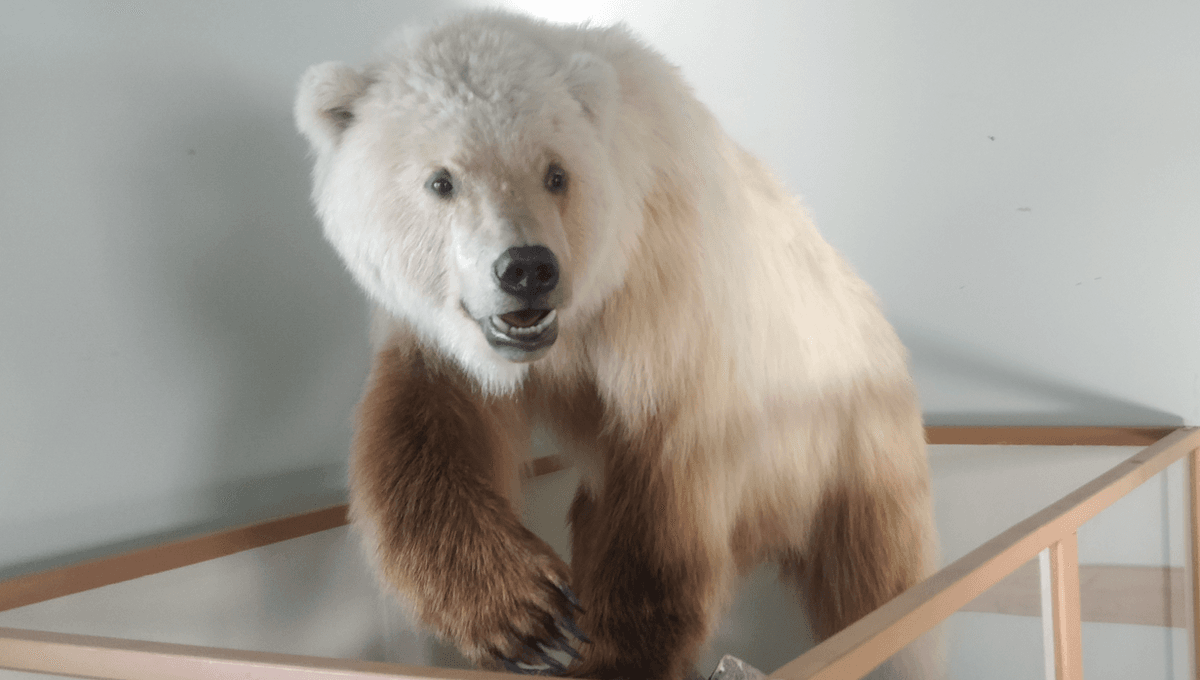
Pizzlies are hybrids born as a result of inter-species romping between a grizzly bear (Ursus arctos horribilis) and a polar bear (Ursus maritimus). Although rare, some scientists believe they could become more common due to climate change meddling with bear habitats in the northernmost stretches of our world.
Polar bears are significantly larger than grizzlies, with fully grown males weighing around 800 kilograms (1,800 pounds) and standing 3 meters (9 feet 10 inches) tall on their hind legs. By comparison, a typical adult male grizzly will weigh 200 to 300 kilograms (400 to 600 pounds). Another visible difference is the polar bear’s whitish fur, as well as their longer skull and snout.
Inuit and Arctic researchers had speculated about pizzlies’ existence for years due to sightings of unusual-looking bears; not a polar bear, yet not quite a grizzly.
“They look like a mishmash of polar bears and grizzly bears. Typically, they look like a white-ish or blonde-ish grizzly bear. They have grizzlies’ dish-shaped faces and those long grizzly bear claws, but they’re mostly white with patches of brown,” Gloria Dickie, environment journalist and author of Eight Bears: Mythic Past and Imperiled Future, told IFLScience.
Their existence wasn’t confirmed by scientists until 2006 when hunters shot a white bear sporting brown patches in Canada’s Northwest Territories. DNA analysis later confirmed that the individual was a hybrid of the two species.
The mating between polar bears and grizzlies doesn’t always appear to be a one-off incident. In 2017, a study traced eight known pizzlies back to one female polar bear that had mated with two grizzly bears.
Scientists have since documented incidences of second-generation hybrids (as in, the offspring of pizzly bears and grizzly bears). At Ulukhaktok airport in Canada’s Northwest Territories, you can find a stuffed bear that researchers have identified as 3/4 grizzly and 1/4 polar bear. Families are never straightforward, eh?
“In most incidences that we know about, a hunter has killed a hybrid,” says Dickie.
“In terms of saying how common it is, it’s difficult. We’re not frequently in places where these hybrids would be living,” she added.
Although the two species are closely related on the family tree – separated by merely 500,000 years of evolution – the evidence of interbreeding is pretty surprising since polar bears and grizzlies often have an adversarial, competitive relationship in the rare incidences they do meet.
Grizzly bears live across much of Western Canada and Alaska, plus some parts of the US like Idaho, Montana, Washington, and Wyoming. Polar bears, on the other hand, live in Arctic regions across a large range that extends all the way from the North Pole, Canada, Alaska, Greenland, Russia, and the Svalbard archipelago of Norway.
These two natural ranges do have some overlap in Western Canada and Alaska, which is most noticeable during the warmer months when polar bears head further south because the fragmented summer sea ice makes it harder to hunt prey.
This clash of species often erupts in aggression. Although polar bears are the larger species, research suggests grizzlies tend to be more dominant in these jostles for power, forcing the polar bears to be displaced from feeding sites.
Clearly, however, some of their inter-species interactions are procreative too. Scientists have never witnessed the act of interbreeding between the two species, so it’s uncertain how and when this behavior would take place.
Climate change is making these kinds of interactions between the two species more likely, much to the concern of some experts. As polar bears are heading further south due to their habitat melting, warming temperatures are pushing grizzly bears further north, increasing the overlap between the two habitats.
“These two animals that never really ran into each other are now being forced to share closer quarters. I guess sometimes that can make for some ‘fun times’, but it’s also a signal that the Arctic is no longer as it once was,” Dickie explained.
This could be very bad news for the planet’s already-suffering population of polar bears. Some scientists fear that hybridization could continue to the point where polar bears will one day be subsumed into the general grizzly population, effectively out-breeding them into extinction.
Source Link: Pizzlies Are Hybrid Bears That Show A Worrying Future For The Arctic